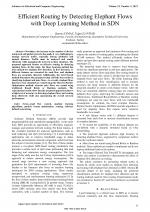| 3/2023 - 7 |
Efficient Routing by Detecting Elephant Flows with Deep Learning Method in SDNAYMAZ, S. |
| Extra paper information in |
| Click to see author's profile in |
| Download PDF |
Author keywords
load flow control, machine learning algorithms, particle swarm optimization, routing, software defined networking
References keywords
flow(14), networks(13), data(12), load(9), software(8), detection(8), routing(7), defined(7), balancing(7), elephant(6)
Blue keywords are present in both the references section and the paper title.
About this article
Date of Publication: 2023-08-31
Volume 23, Issue 3, Year 2023, On page(s): 57 - 66
ISSN: 1582-7445, e-ISSN: 1844-7600
Digital Object Identifier: 10.4316/AECE.2023.03007
Web of Science Accession Number: 001062641900007
SCOPUS ID: 85172349574
Abstract
Nowadays, the increase in the number of devices using local and global networks has made it very challenging to manage network traffic, especially during epidemics and natural disasters. Traffic must be analyzed and routed efficiently while managing the network in these situations. The proposed approach focuses on effective routing by detecting elephant flows. In this study, the Deep Learning method has been utilized for elephant flow detection. In flow detection, 11 different features are extracted for each flow, and elephant flows are accurately detected. Additionally, the Grid Search method determines the parameters that yield the best results in classifying elephant and mice flows. As a result, elephant flows that have been classified are routed using the Discrete-Particle Optimization method, whereas mice flows are routed using traditional Round Robin or Random methods. The experimental results show that the proposed approach achieves a high level of accuracy in detecting elephant flows and routing them effectively while also maintaining the overall network performance. |
| References | | | Cited By |
Web of Science® Times Cited: 1 [View]
View record in Web of Science® [View]
View Related Records® [View]
Updated 3 weeks, 6 days ago
SCOPUS® Times Cited: 2
View record in SCOPUS® [Free preview]
View citations in SCOPUS® [Free preview]
[1] Elephant flow detection intelligence for software-defined networks: a survey on current techniques and future direction, Hamdan, Mosab, Elshafie, Hashim, Salih, Sayeed, Abdelsalam, Samah, Husain, Omayma, Gismalla, Mohammed S. M., Ghaleb, Mustafa, Marsono, M. N., Evolutionary Intelligence, ISSN 1864-5909, Issue 4, Volume 17, 2024.
Digital Object Identifier: 10.1007/s12065-023-00902-7 [CrossRef]
[2] Machine Learning-Based Crack Detection Methods in Ancient Buildings, Fang, Tianke, Hui, Zhenxing, P.Rey, William, Yang, Aihua, Liu, Bin, He, Yuanrong, Proceedings of the 2024 Guangdong-Hong Kong-Macao Greater Bay Area International Conference on Digital Economy and Artificial Intelligence, ISBN 9798400717147, 2024.
Digital Object Identifier: 10.1145/3675417.3675564 [CrossRef]
Disclaimer: All information displayed above was retrieved by using remote connections to respective databases. For the best user experience, we update all data by using background processes, and use caches in order to reduce the load on the servers we retrieve the information from. As we have no control on the availability of the database servers and sometimes the Internet connectivity may be affected, we do not guarantee the information is correct or complete. For the most accurate data, please always consult the database sites directly. Some external links require authentication or an institutional subscription.
Web of Science® is a registered trademark of Clarivate Analytics, Scopus® is a registered trademark of Elsevier B.V., other product names, company names, brand names, trademarks and logos are the property of their respective owners.
Faculty of Electrical Engineering and Computer Science
Stefan cel Mare University of Suceava, Romania
All rights reserved: Advances in Electrical and Computer Engineering is a registered trademark of the Stefan cel Mare University of Suceava. No part of this publication may be reproduced, stored in a retrieval system, photocopied, recorded or archived, without the written permission from the Editor. When authors submit their papers for publication, they agree that the copyright for their article be transferred to the Faculty of Electrical Engineering and Computer Science, Stefan cel Mare University of Suceava, Romania, if and only if the articles are accepted for publication. The copyright covers the exclusive rights to reproduce and distribute the article, including reprints and translations.
Permission for other use: The copyright owner's consent does not extend to copying for general distribution, for promotion, for creating new works, or for resale. Specific written permission must be obtained from the Editor for such copying. Direct linking to files hosted on this website is strictly prohibited.
Disclaimer: Whilst every effort is made by the publishers and editorial board to see that no inaccurate or misleading data, opinions or statements appear in this journal, they wish to make it clear that all information and opinions formulated in the articles, as well as linguistic accuracy, are the sole responsibility of the author.



